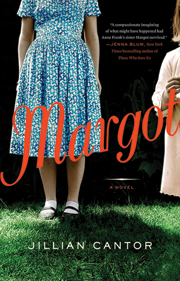“Margot,” by Jillian Cantor, New York: Riverhead Books, 2014
 Ever since the publication of her diary, Anne Frank has become in many ways the iconic image of the Holocaust. We can speak of the 6 million (not to mention the many others whose lives were scarred by the events of that period), but 6 million is still a number. Anne Frank and the others who shared her family’s makeshift attic apartment put a human face on the Nazi reign
Ever since the publication of her diary, Anne Frank has become in many ways the iconic image of the Holocaust. We can speak of the 6 million (not to mention the many others whose lives were scarred by the events of that period), but 6 million is still a number. Anne Frank and the others who shared her family’s makeshift attic apartment put a human face on the Nazi reign
of terror. For example, when Nathan Englander recently published a story about the way the Holocaust affects the consciousness of Jews in our time, he called it “What We Talk About When We Talk About Anne Frank.”
Of the eight people whose lives are described in the diary, only Anne’s father survived. But this has not stopped creative writers from imagining a different outcome. It began with Philip Roth in “The Ghost Writer” (1979), in which the protagonist meets a young woman who resembles Anne Frank as she might have appeared as an adult and, in an extended dream sequence, he imagines that she really is Anne Frank.
In Ellen Feldman’s 2005 novel “The Boy Who Loved Anne Frank,” the author imagines that Peter had survived. Now Jillian Cantor’s new novel, “Margot,” imagines the survival of Anne’s sister, who, having escaped from the transport to the camps, has wound up in Philadelphia, working for a law firm under an assumed name.
The novel describes a brief period of Margot’s new life, as she struggles with her decision to keep not only her family history but her Jewishness itself secret, despite the fact that she works for a Jewish law firm. Clinging to many customs of her past, such as lighting Shabbat candles and refraining from pork, she nevertheless denies her Jewishness, even to herself. “It’s ritual, not religion,” she explains. Above all, she always wears long sweaters to hide her tattoo. Also central to the novel is her attempt to connect with Peter, whom she believes may have survived as well.
In Roth’s novel, Anne kept her survival a secret because she believed that the power of her story would be diluted if she was known to be alive. (Roth also posited that the power of the diary was that it showed the world that the Jews who were slaughtered by the Nazis were no different from other people; i.e., it focused on assimilated Jews). In this novel, on the other hand, there is no such philosophical reason; nor does the novelist really explain why she refuses to contact her father.
Cantor has created an interesting premise and has followed through with a number of nuances the premise provides, such as her discomfort with the distortions in the dramatization of her story or in the diary itself, or her reaction to the film “Some Like it Hot”: “I still do not fully understand the American sense of humor. Hiding is hiding is hiding. What’s so funny about that?”
Unfortunately, the author spends too many pages describing a rather conventional romance between Margot and a young idealistic attorney who works for the firm. This, along with a somewhat flat prose style, makes this novel a pleasant, though not compelling, narrative.
Stuart Lewis holds a doctoral degree in English from the University of Colorado. He writes from Prairie Village, Kan.



